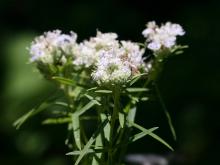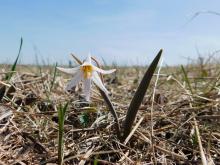Wildflowers, Grasses and Other Nonwoody Plants
Media

Species Types
Scientific Name
Dianthus armeria
Description
Deptford pink has straight, strong, narrow stems that bear small clusters of pink flowers with white dots. Common statewide in sunny, open locations such as pastures and roadsides.
Media

Species Types
Scientific Name
Pycnanthemum tenuifolium
Description
Slender mountain mint has smooth, square stems, opposite, narrow leaves, and dense heads of 2-lipped white (or lavender) flowers. Aromatic and minty, it can be grown at home in the herb garden, and its leaves used for seasoning food.
Media

Species Types
Scientific Name
Agalinis tenuifolia (formerly Gerardia tenuifolia)
Description
Slender false foxglove, or common gerardia, is a small, showy wildflower with slender, opposite leaves and thin, wiry, branching stems. The small, funnel-shaped blossoms are pink or purple, with an upper lip that arches over the 4 hairy stamens.
Media

Species Types
Scientific Name
Erythronium mesochoreum
Description
Prairie dogtooth violet, or prairie trout lily, is a small, early blooming lily that lives in prairies and glades. Its flowers are white and its narrow leaves are folded lengthwise and seem waxy on the undersurface.
Media

Species Types
Scientific Name
Phlox pilosa
Description
Downy phlox, also called prairie phlox, is a perennial wildflower with lance-shaped leaves and showy, rounded clusters of pink or lavender flowers. It is similar to blue phlox, but it grows more often in prairies and other open, sunny, and drier habitats.
See Also
About Wildflowers, Grasses and Other Nonwoody Plants in Missouri
A very simple way of thinking about the green world is to divide the vascular plants into two groups: woody and nonwoody (or herbaceous). But this is an artificial division; many plant families include some species that are woody and some that are not. The diversity of nonwoody vascular plants is staggering! Think of all the ferns, grasses, sedges, lilies, peas, sunflowers, nightshades, milkweeds, mustards, mints, and mallows — weeds and wildflowers — and many more!





















